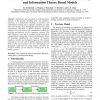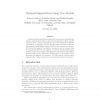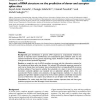14 search results - page 2 / 3 » Variable Order Finite-Context Models in DNA Sequence Coding |
BIOCOMP
2009
13 years 3 months ago
2009
- Identification and annotation of all the functional elements in the genome, including genes and regulatory sequences, is a fundamental challenge in genomics and computational bio...
ICDM
2006
IEEE
13 years 11 months ago
2006
IEEE
Sequence data are abundant in application areas such as computational biology, environmental sciences, and telecommunications. Many real-life sequences have a strong segmental str...
BMCBI
2010
13 years 5 months ago
2010
Background: The investigation of plant genome structure and evolution requires comprehensive characterization of repetitive sequences that make up the majority of higher plant nuc...
ISAMI
2010
13 years 3 months ago
2010
Probabilistic models of languages are fundamental to understand and learn the profile of the subjacent code in order to estimate its entropy, enabling the verification and predicti...
BMCBI
2006
13 years 5 months ago
2006
Background: gene identification in genomic DNA sequences by computational methods has become an important task in bioinformatics and computational gene prediction tools are now es...



